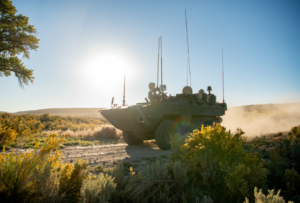Textron Systems [TXT] has officially delivered its Advanced Reconnaissance Vehicle (ARV) prototype to the Marine Corps for the program’s evaluation period, the company said last week.
The Marine Corps received Textron’s Cottonmouth vehicle on Dec. 1, which followed the company’s own verification testing with its ARV prototype from August through Nov. 25.

“Our Cottonmouth vehicle is a completely clean-sheet design that provides transformative reconnaissance capabilities and meets Marine Corps requirements,” David Phillips, Textron’s senior vice president for land and sea systems, said in a statement. “The vehicle was designed from its inception by listening to customer requirements. Because of its smaller size, the Marines can quickly deploy next generational combat power to the fight and lets commanders meet any mission anywhere.”
The Marine Corps last July selected Textron Systems and General Dynamics [GD] for the 22-month ARV prototyping effort, with each company required to deliver a test vehicle ahead of the government evaluation effort to help inform whether to take the program into production (Defense Daily, July 16 2021).
“General Dynamics Land Systems’ Advanced Reconnaissance Vehicle prototype is ready to be delivered this month to the U.S. Marine Corps on the scheduled date provided,” GD Land Systems said in a statement to Defense Daily.
Textron Systems has previously detailed its purpose-built Cottonmouth design for ARV, noting it has tested loading and off-loading the vehicle onto the Ship-to-Shore Connector Landing Craft Air Cushion-100 class, which it is already building for the Navy (Defense Daily, May 4 2021).
“The amphibious 6×6 platform is equipped for sustained reconnaissance with organic unmanned systems capabilities and multi-spectrum sensors which provide seamless communication between the Navy and Marine Corps,” Textron wrote in a statement last week. “Supporting the mission of a mobile scout vehicle, the easy-to-deploy platform swims in open ocean and navigates littoral water obstacles such as bays, estuaries, rivers, light surf and handles any terrain.”
Textron noted the Cottonmouth prototype delivered to the Marine Corps is the second iteration of the vehicle, following an original prototype that went through 3,000 miles of testing.
The company said its contractor verification testing period with the Cottonmouth prototype covered “mobility, swim capability, [vehicle electronics] integration and C4UAS mission capabilities.”
The ARV is set to include a Command, Control, Communications and Computers/Unmanned Aerial Systems, or C4/UAS, payload that will serve as the lead variant for the platform and will allow operators to control both tethered and untethered UAS capabilities.
Textron said its multi-domain C4/UAS suite integrated into the Cottonmouth vehicle will allow it to “serve as the quarterback, or battlefield manager, for the modern battlefield.”
A Marine Corps sources sought notice released last December detailed plans for the C4/UAS platform and a precision fires version as the first two ARV variants, to be followed by a 30mm cannon version, a recovery variant, a logistics variant and a counter-UAS variant in follow-on phases.
BAE Systems told Defense Daily in May it’s eyeing the ARV program as an opportunity to build out additional variants of its own Amphibious Combat Vehicle (ACV), with the company showcasing a C4/UAS version of the ACV and a new Organic Precision Fires concept vehicle at the Modern Day Marine conference in Washington, D.C. (Defense Daily, May 11).
The Marine Corps has previously tasked BAE Systems with integrating a suite of C4/UAS capabilities onto an ACV to study if such a platform could meet the ARV mission requirements.